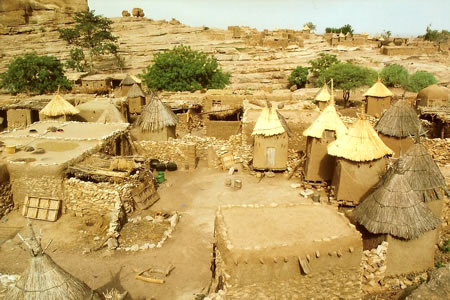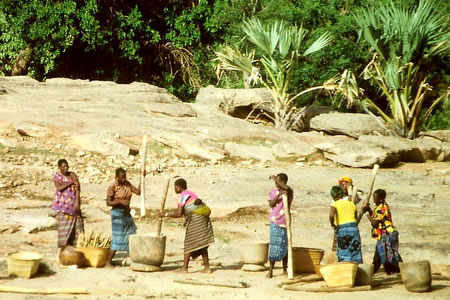English | Dutch |
|
| Doing the Dogon | |
Bamako (Mali), July 23rd 2000 |
|
The Dogon valley is for most travellers to West Africa one of the major highlights. The Dogon valley is one of the last areas in West Africa where the people were able to maintain the culture of many centuries ago. As of today, the people still live in the traditions of their far ancestors. One of the major reasons is the fact that this area is isolated from the other parts of Mali. The Dogon valley still has no electricity, no running water en no roads. The only way to travel through this area is by foot or animal. The valley is beautiful located along an escarpment between two plains of different heights. The escarpment, some 150 kilometres long and hundreds of meters high, has an important role in the culture of the Dogon people.
The Dogon people arrived around 1300 AD after they fled from the high plain. Other groups arriving from the north took over the plains, making it necessary for the Dogon people to travel southwards. They decided to settle down at the escarpment. The people, who lived at the escarpment before the arrival of the Dogon people, were the Telem people. They do not exist anymore and little is known about them. What we know is that they managed to build their houses on the most inaccessible places against the escarpment. We still do not know why they build the houses on these places and how they reached them. The Dogon people believe that the Telem people could fly to reach their houses. Scientists however, believe that the Telem people used ropes, vines and creepers to climb against the escarpment. Due to the dry climate of the past centuries, no vegetation survived against the escarpment. |
|
 |
|
Traditional Dogon village |
|
| The culture of the Dogon is complex and hard. For most people, the culture is difficult to understand and appreciate. Young girls for example, are still circumcised at an age of 10 to 12 years old; even now the Malinese government forbids this. Of course, this happens most of the time in secret. Religious aspects of Dogon culture that can be seen are the many sacred objects around the villages and the colourful ceremonies. Masks play an important role in the Dogon festivals and ceremonies. The most famous ceremony is Singui. During this ceremony, which takes only place once per 60 years (and the last one was in the 1960’s), the Dogon people commemorate the origin of the Dogon culture. The most important mask during this ceremony is the iminana; a mask that looks like a serpent and that can reach a height of 10 metres. This mask plays also an important role in the ceremony after the death of an inhabitant of the village. The Dogon people believe that the spirit leaves the body after decease, in search for another mortal to rest in. By bringing the iminana to the house of the deceased, the people entice the spirit to reside in the mask. After the ceremonies, the mask is stored in one of the caves high on the cliff. The economy of the Dogon valley is dominated by agricultural activities. In contract to many other communities in Africa, both man and women are doing an equal job on the land. Laziness is not appreciated in the Dogon culture. Others do not respect people who are lazy, resulting in the fact that finding a marriage partner is difficult. The market places in the Dogon valley are the most important places to sell the crops. Besides that, the market is the social meeting point for the people from different villages. The traditional week in Dogon consists of only five days, and every fifth day a village organises a market. Because the markets occur on different weekdays, there will be a market in the area every single day in different villages. A successful market always ends with lots of drinking for the men. They gather on a shady place in village and start drinking kojo or chakalow. This is a tepid local millet beer. |
|
 |
|
Dogon women preparing food for the day |
|
| The architecture of the Dogon villages is stunning. In contrast to the first Dogon people who arrived on the escarpment, the houses are not built against the cliffs anymore. The houses that were built in the past against the cliffs, making use of wooden frames and mud, are abandoned. The present time villages are built on the plain on the foot of the escarpment. The wooden frames are replaced by brick structures. The mud is still generally used. The dwellings consist of several buildings, connected to each other by brick walls, surrounding a small yard. The bigger buildings (often the houses in where the people live) have flat roofs, while the smaller granaries have conical straw roofs. The granaries stand on stone legs to protect the maize or other crops from vermin.
The central place of every village is the so-called togu-na. This is a building with a low roof on the central square in where the older people of the village gather to discuss the affairs happening in the village. Women are not allowed to enter this building. The toga-nu is consciously built with a low roof, so that man must remain seated. This prevents that discussions will turn into arguments or fights. Another special building, located in the outskirts of the village, is a building in where women must stay during menstruation. Menstruation is seen as unclean, and for that reason women are supposed to stay in this building. Interestingly, all women of the village use the same building. A trek through the Dogon valley is a fabulous experience. It is the way to be part of this culture for a couple of days. Be sure to hire a guide, because you need him to get access to, and be accepted in the villages. Besides that, the guide knows more about the Dogon valley than most books, so you get more out of the trek. Finally, hiring a guide is also a good way to invest in the local economy by providing employment for the local people. | |